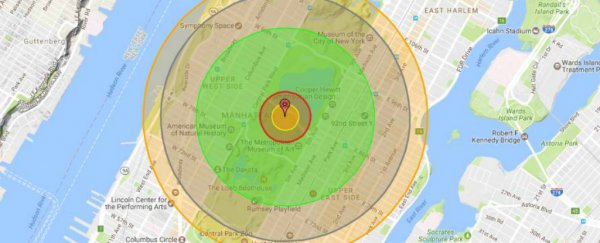It's been nearly 80 years since two nuclear bombs were detonated over the Japanese cities of Hiroshima and Nagasaki, killing at least 129,000 people, and causing devastating, long-term health effects.
To date, those are the only instances of nuclear weapons being used for warfare, but the reality is there are roughly 12,700 warheads remaining in the world today. So, what would happen if nuclear war broke out tomorrow?
Don't panic – this is just a hypothetical. But in the video below, the team from AsapSCIENCE breaks down the science of nuclear bombs to predict how likely you'd be to survive. Let's just say, in the case of a nuclear blast, you would want to be wearing white.
First, let's get this out of the way – there is no clear-cut way to estimate the impact of a single nuclear bomb, because it depends on many factors, including the weather on the day it's dropped, the time of day it's detonated, the geographical layout of where it hits, and whether it explodes on the ground or in the air.
But, generally speaking, there are some predictable stages of a nuclear bomb blast that can affect the likelihood of your survival. (You can also explore this chilling interactive to find out how a nuclear blast would spread through the area where you live.)
As the video above explains, approximately 35 percent of the energy of a nuclear blast is released in the form of thermal radiation. Since thermal radiation travels at approximately the speed of light, the first thing that will hit you is a flash of blinding light and heat.
The light itself is enough to cause something called flash blindness – a usually temporary form of vision loss that can last a few minutes.
The AsapSCIENCE video considers a 1 megaton bomb, which is 80 times larger than the bomb detonated over Hiroshima, but much smaller than many modern nuclear weapons.
For a bomb that size, people up to 21 km (13 miles) away would experience flash blindness on a clear day, and people up to 85 km (52.8 miles) away would be temporarily blinded on a clear night.
Heat is an issue for those closer to the blast. Mild, first-degree burns can occur up to 11 km (6.8 miles) away, and third-degree burns – the kind that destroy and blister skin tissue – could affect anyone up to 8 km (5 miles) away. Third-degree burns that cover more than 24 percent of the body would likely be fatal if people don't receive medical care immediately.
Those distances are variable, depending not just on the weather, but also on what you're wearing – white clothes can reflect some of the energy of a blast, while darker clothes will absorb it.
That's unlikely to make much difference for those unfortunate enough to be at the center of the explosion, though.
The temperatures near the site of the bomb blast during the Hiroshima explosion were estimated to be 300,000 degrees Celsius (540,000 degrees Fahrenheit) – which is roughly 300 times hotter than the temperature bodies are cremated at, so humans were almost instantly reduced to the most basic elements, like carbon.
But for those slightly farther away from the center of the blast, there are other effects to consider aside from heat. The blast of a nuclear explosion also drives air away from the site of the explosion, creating sudden changes in air pressure that can crush objects and knock down buildings.
Within a 6-km (3.7-mile) radius of a 1-megaton bomb, blast waves would produce 180 metric tons of force on the walls of all two-story buildings, and wind speeds of 255 km/h (158 mph). In a 1-km (0.6-mile) radius, the peak pressure is four times that amount, and wind speeds can reach 756 km/h (470 mph).
Technically, humans can withstand that much pressure, but most people would be killed by falling buildings.
If you somehow survive all of that, there's still the radiation poisoning to deal with – and the nuclear fallout. AsapSCIENCE touches on this in the video above, but the ongoing effects on the planet are longer-lasting than you might expect.
For example, a simulation study published in 2019 found that a nuclear war between the United States and Russia would plunge Earth into a nuclear winter within days, due to the levels of smoke and soot released into the atmosphere.
We also know that radioactive particles can travel remarkably far; a recent study found that remnants of radioactive carbon from Cold War nuclear bomb tests have been found all the way down in the Mariana Trench, the deepest point of the world's oceans.
Again, all of this is hypothetical – there are international treaties in place to stop the spread and use of nuclear weapons, so we hope you never need to know any of this information for real.
However, to find out more about the current state of nuclear weaponry in the world, including the scale of the bombs, you can visit the Nuclear Notebook at the Bulletin of the Atomic Scientists.
A version of this article was originally published in January 2017. Due to overwhelming reader interest, we have now updated this article in February 2022.
